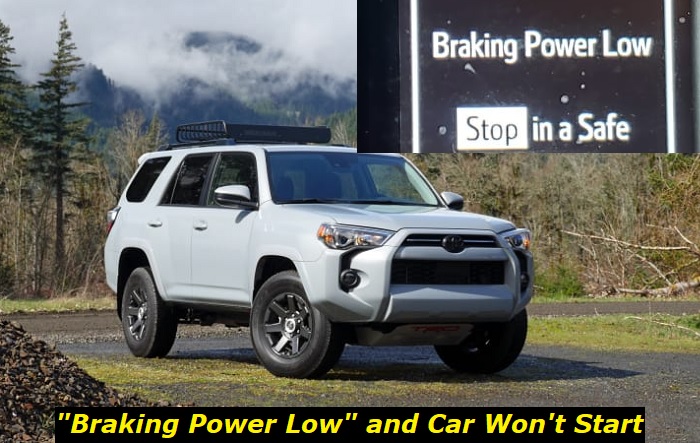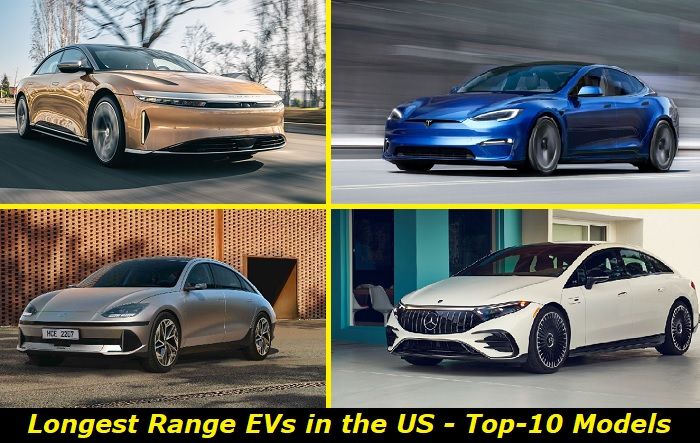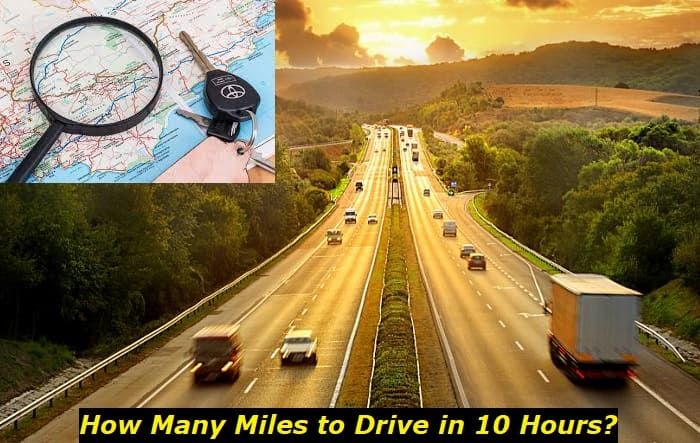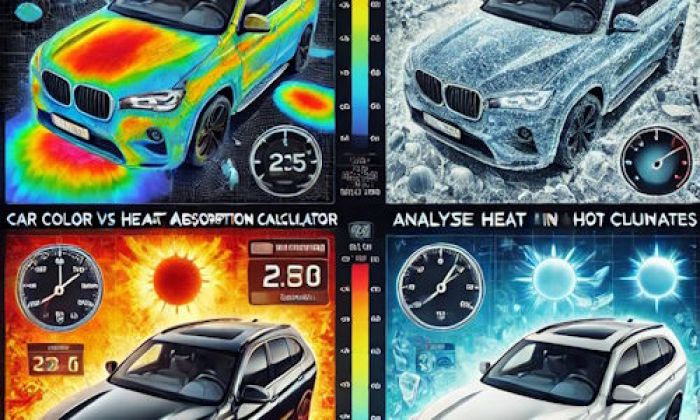Seeing a dashboard message telling you that there's low braking power while your car isn't starting is possible. And various reasons that could make these two situations happen simultaneously. We've addressed them in this detailed article.
Seeing a "braking power low" message while your car isn't starting could mean that there's a fault with the battery and/or braking system. It could be an old, weak, or faulty battery affecting the EBCM (electronic brake control module) and also not allowing your car to start.

What Is Braking Power in a Car?
Braking power is the force of your car slowing down when you depress the brake pedal. The force depends on how hard you step on the pedal and the brake type. Keep in mind that the more power, the shorter the distance before your car stops.
Hydraulic fluid applies pressure on the brake pads when the brake pedal is depressed. The pads will then push against the brake rotors which will cause the vehicle to stop or slow down. Inadequate hydraulic fluid pressure will result in your brakes not working well.
1) Braking Power of Different Brake Types
The two major brake types (drum brakes and disc brakes) apply braking power in different ways. Disc brakes function by utilizing calipers to push the brake pads against the brake rotor or spinning disc. The friction created will slow down the wheels. Disc brakes are the most common car brake type.
On the other hand, drum brakes operate in a similar manner as disc brakes, but with the pads pressing into the drum. They're less common than disc brakes and are mostly found on old model-year vehicles. The drum types are less efficient than the disc types.
2) Braking Power While Driving
Loss of braking power while driving is one of the worst experiences a driver can have, especially on the freeway. Be careful when hitting the brake pedal as too much force could lock the wheels and make the tires skid.
You'll have to pump the brakes if your power brakes go out. This is because power brakes utilize vacuum pressure to aid in bringing the vehicle to a stop. Inadequate vacuum pressure will mean that the brakes won't perform well.
Experiencing "Braking Power Low, Car Won't Start"
There's a new safety feature on modern cars that necessitates the driver to engage the brakes when starting the vehicle. Such a mechanism means the engine is affected by the braking system in a way.
Your car won't start if the brake pedal isn't engaged or if there's low braking power in such vehicles. Remember the possibility of the cause being the battery as well.
The "braking power low" message might show with the illumination of a dashboard warning light that has a triangle with an exclamation mark as its symbol. This indicator isn't typically related to a specific issue. It only means that you need to read the urgent message or there's a problem which doesn't have its own warning light.
Causes of Low Braking Power While the Vehicle Isn't Starting
Here, we'll deal with the causes of your car not starting in separate subheadings for the battery and braking system.
1) Braking System Issues
The cause of your brake's low power may be any of the following braking system issues:
- Low Brake Fluid Level
Brake fluid is in a brake line that links all the wheels. The steel parts of the brake line are susceptible to corrosion and may get leaky. The leak will result in low brake fluid levels. Check the fluid's level to make sure it's not low and top it up if necessary. The brake line may have to be replaced or the holes patched.
- Brake Line Bending, Clogging, Obstruction, or Overheating
Impact or accidents can make the brake line bend and its internal passageway obstructed. So the fluid won't flow freely, leading to low braking power. Overheating can make the fluid heat up and become solid, thereby blocking the line. It's best to swap out the brake line in any of such cases.
- Air in the Brake Fluid
Air may get into the brake fluid in a variety of ways. For instance, the fluid absorbs ambient water and produces vapor from it when boiling. The vapor contains oxygen which can lead to loss of hydraulic power. Air can also get into the system during maintenance. Bleed the fluid to get rid of any sign of air bubbles.
- Worn-Out Brake Pads
Brake pad wear is inevitable, although it may be sped up by other braking system issues. Check the pads to see if a swap is needed, especially if the brake pad wear indicator didn't give any signal. Brake pad wear will reduce the friction needed to make the vehicle stop.
Note: There may be a brake pad wear sensor fault.
- Failing Vacuum Pump
The job of a vacuum pump is the removal of air from the vacuum booster. This will create a vacuum that will ensure optimal braking power even with minimal effort from the driver. A vacuum gauge can quickly call your attention to a faulty vacuum pump. It's a serious safety hazard, so have the pump replaced ASAP.
- Brake Rotor Damage or Deformity
This could happen as a result of accidents or intense impact. Check the rotor for such abnormalities and get it replaced if found to be bad.
- Dirty Brakes
The brakes could be dirty after off-roading or driving through an area where there's a lot of dirt or dust. Purchase a brake cleaning kit to get rid of dirt, sand, dust, corrosive materials, etc. You'd have to remove the wheels, of course.
- Fault in the Master Brake Cylinder
The master brake cylinder's roles include brake fluid storage and hydraulic pressure generation. Any issue with this cylinder will adversely affect braking power. The cylinder can get damaged by external impact or accidents, leading to a fluid leak. It can also become defective after long-term usage.
- Valve Defect
The vacuum booster has a booster check valve that's responsible for air and pressure buildup removal as well as vacuum maintenance. These functions help in maximizing braking power. So the vacuum in the brake booster will be lost when the valve is faulty. Hence braking power won't be adequate.
The valve is supposed to last as long as the vehicle's life span. But this part can get damaged due to various reasons. Swap out the booster check valve whenever it malfunctions. It can cause the brake pedal to be spongy and make the engine stall when you try to start your car.
Other causes of low braking power include problems with the pedal, caliper, ECM (electronic control module), ABS (anti-lock braking system), vacuum hose, vehicle software, wiring, speed sensor, etc.
2) Battery Issues
Try the steps in this section to solve the issue of your car not starting if the suspect is the battery. Begin with the first one downwards.
- Use a Diagnostic Scan Tool
The first and best thing to always try before anything else (such as physical checks) is to hook up a diagnostic scanner to your car. You may just be able to pinpoint the cause/causes of the problem. And you may be fortunate that the fix requires DIY steps. The fix could even be carried out by the scan tool alone.
Note: This step should also be taken when looking for braking system issues. Proceed with the other fixes in this section in the absence of a scan tool.
- Jump-start the Car
As stated earlier, your battery may be the culprit. For example; low voltage or charge, shorting, old age, etc. You can test the battery's condition with a multimeter before anything else to see whether a jump-start is necessary or a reset instead. Jump-start your car using jumper cables and another vehicle's battery terminals.
- Reset the Battery
Try this in the absence of the need to jump-start your car. A battery disconnection and reconnection to reset the unit. Unplug the battery and wait for 15 minutes before plugging it back.
- Troubleshoot the Starter
Try to troubleshoot the starter when the above two fixes don't work. One DIY method is the use of the transponder key/key fob to test whether the starter is working or not.
The starter may not be functioning if the lights come on after rotating the key and the engine doesn't crank. You'd have to get a professional to check the starter in this case.
However, the engine cranking over and not starting could be a sign of problems with the fuel or spark plugs. You'll have to call a professional to render roadside service if the jump-starting, battery reset, or other fixes don't work. The requirements and/or tools for jump-starting your car may not be available as well.
Note: Other causes of a car not starting could be a faulty or dirty fuel filter and pump, an empty gas tank, a failing ignition switch, etc.
Conclusion
Keep in mind that the starting and braking issues could be coincidental. This will mean more work for you or the mechanic. Ensure that you conduct proper routine maintenance of your braking system and the parts that help your car to start.
About the authors
The CarAraC research team is composed of seasoned auto mechanics and automotive industry professionals, including individuals with advanced degrees and certifications in their field. Our team members boast prestigious credentials, reflecting their extensive knowledge and skills. These qualifications include: IMI: Institute of the Motor Industry, ASE-Certified Master Automobile Technicians; Coventry University, Graduate of MA in Automotive Journalism; Politecnico di Torino, Italy, MS Automotive Engineering; Ss. Cyril and Methodius University in Skopje, Mechanical University in Skopje; TOC Automotive College; DHA Suffa University, Department of Mechanical Engineering






Add comment